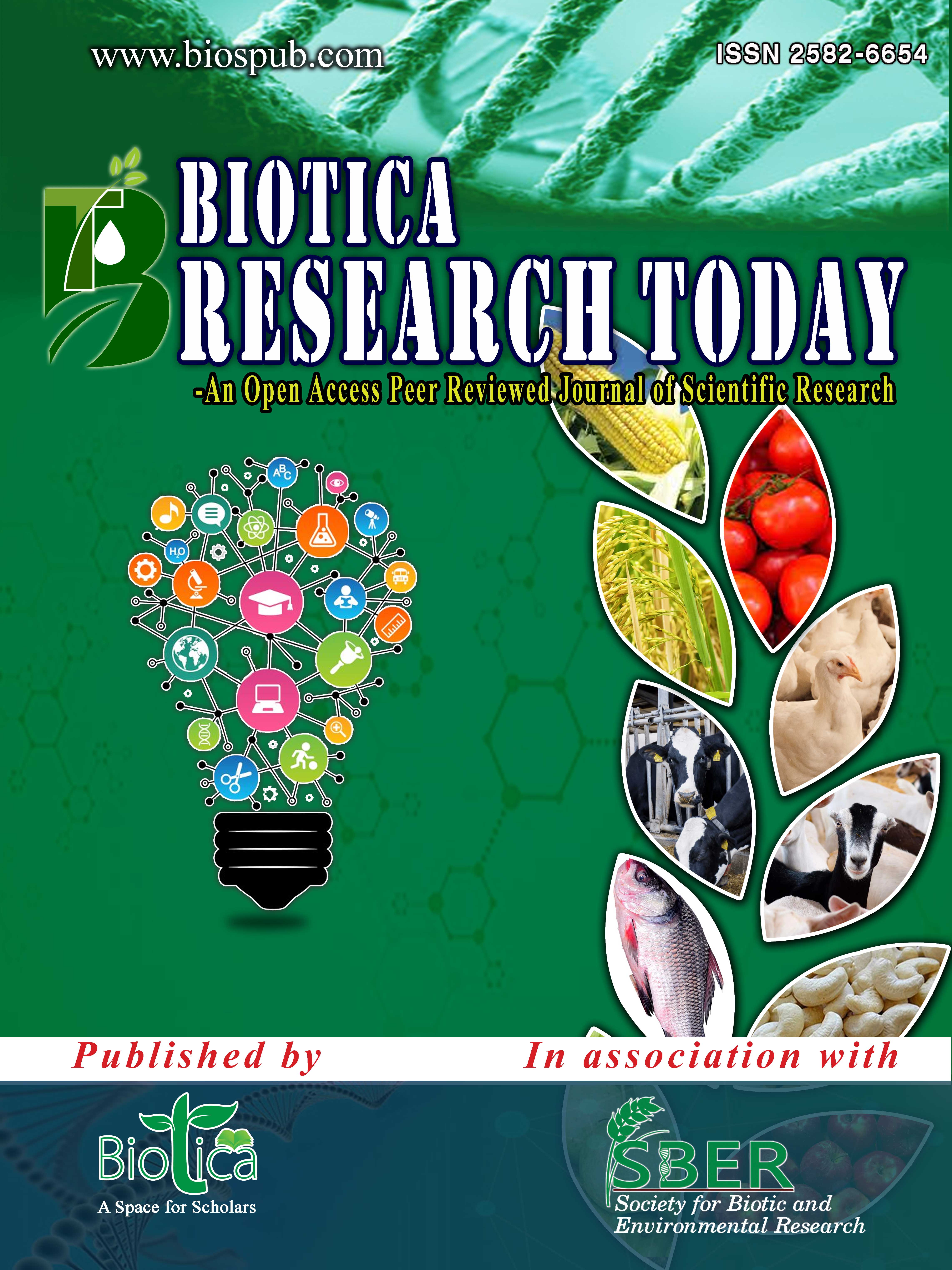Evaluation of Post-Harvest Microbial Deterioration of Ripe Banana Fruits in Different Markets
DOI:
https://doi.org/10.54083/PHA/2.1.2024/01-06Keywords:
Bacteria, Banana, Deterioration, Fungi, Post-harvest, SpoilageAbstract
This study intends to evaluate the influence of microflora in various types of banana fruits on moisture content and health risks related to bacterial growth at different fruit ages. Over four weeks, 120 banana fruit samples were gathered from three marketplaces in Kano State, Nigeria and dissected for pH, moisture content and microbiota. These three samples were then dissected to perform tests on pH, moisture content and microbiota. Some were subject to a moisture content that ranged from 77.22% to 80.29% and the samples' pH values ranged from 4.60 to 5.10. The fungal counts displayed a range spanning from 1.40×106 to 3.30×106 cfu ml-1, while the bacterial counts exhibited a broader spectrum, fluctuating between 3.80×106 and 7.30×106 cfu ml-1. The bacteria identified in the samples were Proteus vulgaris, Bacillus sp., Xanthomonas campestris, Corynebacterium xerosis, Pseudomonas sp., Erwinia carotovora, Dickeya parasidiaca and Ralstonia solanacearum. The fungal isolates included Aspergillus niger, Fusarium sp., Alternaria sp., Mucor sp., Cordana johnsonii, Chrysonilia sp., Cladosporium sp., Doratomyces microspores, Rhizopus stolonifer and Colletotrichum musae. Fungi and bacteria detected in these samples prove their significant contribution causing the deterioration after harvest. This results in post-harvest diseases which consequently lead to the decline in the fruit's quantity and quality. Apart from the diminished commercial value of this kind of fruit, it can also pose chemical dregs, a health hazard to human beings. The knowledge gained from this research may facilitate the development of strategies for controlling banana fruit spoilage, resulting in improved product quality before consumption.
Downloads
References
Al-Otibi, F., Al-Zahrani, R.M., Marraiki, N., 2023. Biodegradation of selected hydrocarbons by Fusarium species isolated from contaminated soil samples in Riyadh, Saudi Arabia. Journal of Fungi 9(2), 216. DOI: https://doi.org/10.3390/jof9020216.
Alwakeel, S.S., Ameen, F., Al Gwaiz, H., Sonbol, H., Alghamdi, S., Moharram, A.M., Al-Bedak, O.A., 2021. Keratinases produced by Aspergillus stelliformis, Aspergillus sydowii and Fusarium brachygibbosum isolated from human hair: yield and activity. Journal of Fungi 7(6), 471. DOI: https://doi.org/10.3390/jof7060471.
Ardiyansyah, A., Kurnianto, M.F., Poerwanto, B., Wahyono, A., Apriliyanti, M.W., Lestari, I.P., 2020. Monitoring banana deterioration using intelligent packaging containing Brazilian extract (Caesalpina sappan L.). IOP Conference Series: Earth and Environmental Science 411(1), 012043. DOI: https://doi.org/10.1088/1755-1315/411/1/012043.
Busari-Ahmed, O., Idris-Adeniyi, K.M., Lawal, A.O., 2015. Food security and post-harvest losses in fruit marketing in Lagos Metropolis, Nigeria. Discourse Journal of Agriculture and Food Sciences 3(3), 52-58.
Cho, B.H., Koseki, S., 2021. Determination of banana quality indices during the ripening process at different temperatures using smartphone images and an artificial neural network. Scientia Horticulturae 288, 110382. DOI: https://doi.org/10.1016/j.scienta.2021.110382.
Ekafitri, R., Kurniawan, Y.R., Desnilasari, D.N., Indriati, A., 2020. Shelf-life assessment of energy banana bar using acceleration method with critical moisture content approach. Food Science and Technology 41(Suppl 1), 163-168. DOI: https://doi.org/10.1590/fst.13120.
Etim, P.J., Simonyan, K.J., Eke, A.B., 2022. Proximate and microbial composition of cooking banana dried using an active indirect mode solar dryer. International Journal of Fruit Science 22(1), 215-223. DOI: https://doi.org/10.1080/15538362.2021.2023066.
Gamez, R.M., Ramirez, S., Montes, M., Cardinale, M., 2020. Complementary dynamics of banana root colonization by the plant growth-promoting Rhizobacteria Bacillus amyloliquefaciens Bs006 and Pseudomonas palleroniana Ps006 at spatial and temporal scales. Microbial Ecology 80, 656-668. DOI: https://doi.org/10.1007/s00248-020-01571-0.
Ganduri, V. S. R., 2020. Evaluation of pullulan‐based edible active coating methods on Rastali and Chakkarakeli bananas and their shelf‐life extension parameters studies. Journal of Food Processing and Preservation 44(4), e14378. DOI: https://doi.org/10.1111/jfpp.14378.
Jaiswal, K.K., Banerjee, I., Dutta, S., Verma, R., Gunti, L., Awasthi, S., Bhushan, M., Kumar, V., Alaimi, M.F., Hussain, A., 2022. Microwave-assisted polycrystalline Ag/AgO/AgCl nanocomposites synthesis using banana corm (rhizome of Musa sp.) extract: Characterization and antimicrobial studies. Journal of Industrial and Engineering Chemistry 107, 145-154. DOI: https://doi.org/10.1016/j.jiec.2021.11.041.
Joshi, A., Kalauni, D., Tiwari, U., 2020. Application of good agricultural practices (GAP) by the banana farmers of Chitwan, Nepal. BioRxiv 148551. DOI: https://doi.org/10.1101/2020.06.12.148551.
Khanjani, M.H., Sharifinia, M., 2022. Biofloc as a food source for banana shrimp Fenneropen aeusmerguiensis postlarvae. North American Journal of Aquaculture 84(4), 469-479. DOI: https://doi.org/10.1002/naaq.10261.
Kuang, J.F., Wu, C.J., Guo, Y.F., Walther, D., Shan, W., Chen, J.Y., Chen, L., Lu, W.J., 2021. Deciphering transcriptional regulators of banana fruit ripening by regulatory network analysis. Plant Biotechnology Journal 19(3), 477-489. DOI: https://doi.org/10.1111/pbi.13477.
Martínez-Solórzano, G.E., Rey-Brina, J.C., 2021. Bananas (Musa AAA): Importance, production and trade in COVID-19 times. Agronomía Mesoamericana 32(3), 1034-1046. DOI: https://doi.org/10.15517/am.v32i3.43610.
Meena, P.K., Prajapati, R., Sherekar, S., Sreeja, R., Claudia, K.L., 2020. Development and evaluation of biodegradable plastic using banana peel starch. B.Tech Thesis, Submitted to Department of Food and Agricultural Process Engineering, Kelappaji College of Agricultural Engineering & Technology, Kerala Agricultural University, Tavanur, Malappuram - 678 573, Kerala, India. p. 41.
Megha, S., Parkash, V., Chhetri, R., Gaur, A., Agnihotri, R., 2023. Native diversity of endotrophic mycorrhizal fungi of forage grass species occurring in Asan River Basin, Mussoorie Hills, Uttarakhand. Plant Health Archives 1(3), 73-81. DOI: https://doi.org/10.54083/PHA/1.3.2023/73-81.
Mon, Y.Y., Bidabadi, S.S., Oo, K.S., Zheng, S.J., 2021. The antagonistic mechanism of rhizosphere microbes and endophytes on the interaction between banana and Fusarium oxysporum f. sp. cubense. Physiological and Molecular Plant Pathology 116, 101733. DOI: https://doi.org/10.1016/j.pmpp.2021.101733.
Mostafa, H.S., 2021. Banana plants as a source of valuable antimicrobial compounds and their current applications in the food sector. Journal of Food Science 86(9), 3778-3797. DOI: https://doi.org/10.1111/1750-3841.15854.
Nayab, D.E., Akhtar, S., 2023. Green synthesized silver nanoparticles from eucalyptus leaves can enhance the shelf life of bananas without penetrating the pulp. Plos ONE 18(3), e0281675. DOI: https://doi.org/10.1371/journal.pone.0281675.
Noohi, N., Papizadeh, M., 2022. Study of biodeterioration potential of microorganisms isolated in the paintings storeroom of Mouze Makhsus Museum, Golestan Palace, Tehran. Studies in Conservation 68(7), 720-730. DOI: https://doi.org/10.1080/00393630.2022.2118269.
Olivares, B.O., Vega, A., Rueda Calderón, M.A., Montenegro-Gracia, E., Araya-Almán, M., Marys, E., 2022. Prediction of banana production using epidemiological parameters of Black Sigatoka: An application with random forest. Sustainability 14(21), 14123. DOI: https://doi.org/10.3390/su142114123.
Ranjha, M.M.A.N., Irfan, S., Nadeem, M., Mahmood, S., 2022. A comprehensive review of nutritional value, medicinal uses and banana processing. Food Reviews International 38(2), 199-225. DOI: https://doi.org/10.1080/87559129.2020.1725890.
Saha, C.K., Ahamed, M.K., Hosen, M.S., Nandi, R., Kabir, M., 2021. Post-harvest losses of banana in fresh produce marketing chain in Tangail district of Bangladesh. Journal of the Bangladesh Agricultural University 19(3), 389-397. DOI: https://doi.org/10.5455/JBAU.74902.
Sengupta, A., Sarkar, A., 2022. Synthesis and characterization of nanoparticles from neem leaves and banana peels: A green prospect for dye degradation in wastewater. Ecotoxicology 31, 537-548. DOI: https://doi.org/10.1007/s10646-021-02414-5.
Sharma, A., Dutta, P., Mahanta, M., Kumari, A., Yasin, A., 2023. Botanicals as a source of nanomaterial for pest and disease management. Plant Health Archives 1(3), 96-101. DOI: https://doi.org/10.54083/PHA/1.3.2023/96-101.
Sugianti, C., Imaizumi, T., Thammawong, M., Nakano, K., 2022. Recent postharvest technologies in the banana supply chain. Reviews in Agricultural Science 10, 123-137. DOI: https://doi.org/10.7831/ras.10.0_123.
Taweechat, C., Wongsooka, T., Rawdkuen, S., 2021. Properties of banana (Cavendish spp.) starch film incorporated with banana peel extract and its application. Molecules 26(5), 1406. DOI: https://doi.org/10.3390/molecules26051406.
Yazew, T., 2022. Therapeutic food development from maize grains, pulses and cooking banana fruits to prevent severe acute malnutrition. The Scientific World Journal 2022, 3547266. DOI: https://doi.org/10.1155/2022/3547266.
Zhang, J., Arif, M., Shen, H., Sun, D., Pu, X., Hu, J., Lin, B., Yang, Q., 2022. Genomic comparisons and phenotypic diversity of Dickeya zeae strains causing bacterial soft rot of banana in China. Frontiers in Plant Science 13, 822829. DOI: https://doi.org/10.3389/fpls.2022.822829.
Downloads
Published
How to Cite
Issue
Section
License
Copyright (c) 2024 Plant Health Archives

This work is licensed under a Creative Commons Attribution-NonCommercial-NoDerivatives 4.0 International License.
Submission of a manuscript implies that when the manuscript is accepted for publication, the authors agree to automatic transfer of the copyright to the publisher (or grant the Publisher exclusive publication and dissemination rights). The Biotica, as the publisher, has the right to enter into any agreement with any organization in India or abroad engaged in reprography, photocopying, storage and dissemination of information contained in this journal. The Biotica has no objection in using the material, provided the information is being utilized for academic purpose but not for commercial use. Due credit line should be given to Biotica where information will be utilized.









 |
|




